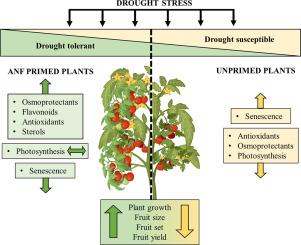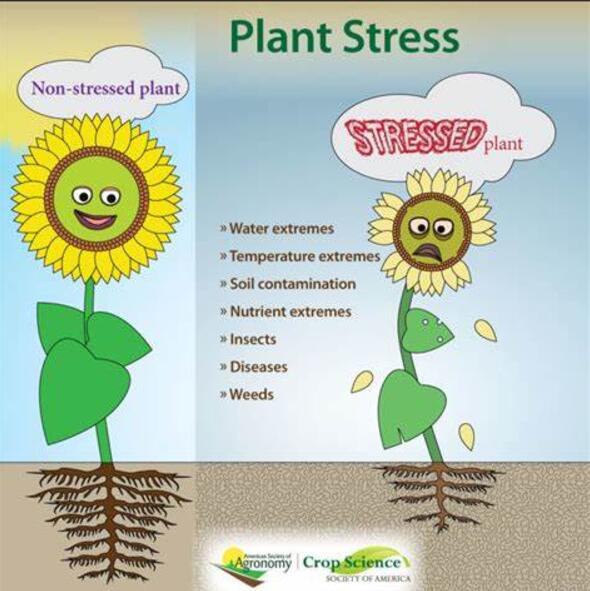海藻生物刺激素提高番茄果实产量和抗旱性的生理和分子效应
IF 6.8
Q1 PLANT SCIENCES
引用次数: 0
摘要
西红柿是欧洲种植最广泛的蔬菜作物之一。本研究描述了一种在胁迫事件发生前用Ascophyllum nodosum (ANF)提取物处理番茄植株的方法,该方法通过称为分子启动的过程,在分子水平上使植株对胁迫条件做出更有效的反应。番茄茄属植物。矮小番茄品种Micro-Tom在开花阶段通过叶面喷施ANF预处理,随后经受干旱条件。与未经处理的植株相比,经anf处理的植株在中度和重度干旱条件下均表现出更高的生长、产量和抗逆性。叶片转录组学研究表明,启动处理保留了光合机制,诱导了抗坏血酸、过氧化物酶、GABA、谷胱甘肽和黄烷醇生物合成等应激保护基因。同时,该处理抑制了与乙烯生物合成相关的关键衰老相关基因,以及几种WRKY和NAC转录因子。代谢组学分析表明,ANF通过促进GABA、脯氨酸、麦芽糖、抗坏血酸、槲皮素和生物素等抗旱初级和次级代谢物的积累诱导抗旱,这些代谢物在干旱期间具有渗透保护作用和自由基清除剂的作用。转录组学和代谢组学的综合分析表明,ANF处理抑制了衰老过程,维持了光合活性,诱导了保护性代谢物和氨基酸的积累,促进了植物在干旱条件下的生存和生长。总的来说,本研究为基于生物刺激素的分子启动机制提供了新的见解,并为准确应用这种ANF分子启动剂来提高作物生产力和减轻干旱期间的产量损失提供了一种基于知识的方法,为气候变化时代的粮食安全做出贡献。本文章由计算机程序翻译,如有差异,请以英文原文为准。

Physiological and molecular insights into the effect of a seaweed biostimulant on enhancing fruit yield and drought tolerance in tomato
Tomato is one of the most widely grown vegetable crops in Europe. This study describes an approach for treating tomato plants with an extract of Ascophyllum nodosum (ANF) prior to a stress event, which prepares the plants at the molecular level to respond more effectively to stress conditions, through a process known as molecular priming. Solanum lycopersicum L. cv. Micro-Tom, a dwarf tomato variety, was pre-treated with ANF via foliar spray during the flowering phase and subsequently subjected to drought conditions. ANF-treated plants exhibited enhanced growth, fruit yield, and stress tolerance under both moderate and severe drought conditions compared to untreated plants. Transcriptomic studies in leaves revealed that the priming treatment preserved the photosynthetic machinery, inducing stress-protective genes involved in ascorbate, peroxidase, GABA, glutathione, and flavanol biosynthesis. Simultaneously, the treatment repressed key senescence-related genes associated with ethylene biosynthesis, as well as several WRKY and NAC transcription factors. Metabolome analysis demonstrated that ANF induces drought tolerance by promoting the accumulation of stress-protective primary and secondary metabolites, such as GABA, proline, maltose, ascorbic acid, quercetin, and biotin, which can act as osmoprotectants and free radical scavengers during drought. Combined transcriptome and metabolome analyses suggest that ANF treatment represses the senescence process, maintains photosynthetic activity, and induces the accumulation of protective metabolites and amino acids, promoting plant survival and growth under drought. Overall, this research provides new insights into the molecular mechanisms underlying biostimulant-based molecular priming and offers a knowledge-based approach for the accurate application of this ANF molecular priming agent to increase crop productivity and mitigate yield loss during drought, contributing to food security in the era of climate change.
求助全文
通过发布文献求助,成功后即可免费获取论文全文。
去求助
来源期刊

Plant Stress
PLANT SCIENCES-
CiteScore
5.20
自引率
8.00%
发文量
76
审稿时长
63 days
期刊介绍:
The journal Plant Stress deals with plant (or other photoautotrophs, such as algae, cyanobacteria and lichens) responses to abiotic and biotic stress factors that can result in limited growth and productivity. Such responses can be analyzed and described at a physiological, biochemical and molecular level. Experimental approaches/technologies aiming to improve growth and productivity with a potential for downstream validation under stress conditions will also be considered. Both fundamental and applied research manuscripts are welcome, provided that clear mechanistic hypotheses are made and descriptive approaches are avoided. In addition, high-quality review articles will also be considered, provided they follow a critical approach and stimulate thought for future research avenues.
Plant Stress welcomes high-quality manuscripts related (but not limited) to interactions between plants and:
Lack of water (drought) and excess (flooding),
Salinity stress,
Elevated temperature and/or low temperature (chilling and freezing),
Hypoxia and/or anoxia,
Mineral nutrient excess and/or deficiency,
Heavy metals and/or metalloids,
Plant priming (chemical, biological, physiological, nanomaterial, biostimulant) approaches for improved stress protection,
Viral, phytoplasma, bacterial and fungal plant-pathogen interactions.
The journal welcomes basic and applied research articles, as well as review articles and short communications. All submitted manuscripts will be subject to a thorough peer-reviewing process.
 求助内容:
求助内容: 应助结果提醒方式:
应助结果提醒方式:


